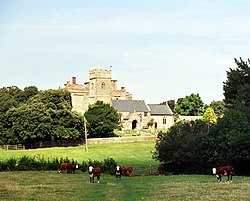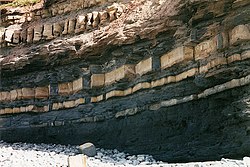East Quantoxhead
| East Quantoxhead | |
|---|---|
 East Quantoxhead Church |
|
 Cliff Face East Quantoxhead |
|
| East Quantoxhead shown within Somerset | |
| Population | 104 (2011) |
| OS grid reference | ST134434 |
| District | |
| Shire county | |
| Region | |
| Country | England |
| Sovereign state | United Kingdom |
| Post town | BRIDGWATER |
| Postcode district | TA5 |
| Dialling code | 01278 |
| Police | Avon and Somerset |
| Fire | Devon and Somerset |
| Ambulance | South Western |
| EU Parliament | South West England |
| UK Parliament | |
East Quantoxhead is a village in West Somerset, 3 miles (5 km) from West Quantoxhead, 4 miles (6 km) east of Williton, and 13 miles (21 km) west of Bridgwater, within the Area of Outstanding Natural Beauty in Somerset, England.
Above the village at Black Ball Camp are an Iron Age hill fort and evidence of Bronze Age burials.
The parish of East Quantoxhead was part of the Williton and Freemanners Hundred.
The village has a manor house, thatched cottages, medieval tithe barn, its own duck pond and mill house dating from 1725. The manor house known, as Court House, has a medieval tower and other parts of the building which date from the 17th century. It has been designated as a grade I listed building. The manor was granted to Ralph Pagnall after the Norman Conquest passing down through generations to the Luttrells. No part of the estate has been sold since its grant around 1070 and is still owned by the descendants of the Paganel and Luttrell families. This required a special act of parliament in the 1920s to enable council houses to be built on land which was not freehold, contrary to the rules in the rest of the country.
The village used to have a small harbour which brought in limestone for local limekilns and exported alabaster. It is thought that it was also used for smuggling.
At some time before 1725 Perry Hill was the site of a copper mine.
The parish council has responsibility for local issues, including setting an annual precept (local rate) to cover the council’s operating costs and producing annual accounts for public scrutiny. The parish council evaluates local planning applications and works with the local police, district council officers, and neighbourhood watch groups on matters of crime, security, and traffic. The parish council's role also includes initiating projects for the maintenance and repair of parish facilities, as well as consulting with the district council on the maintenance, repair, and improvement of highways, drainage, footpaths, public transport, and street cleaning. Conservation matters (including trees and listed buildings) and environmental issues are also the responsibility of the council.
...
Wikipedia

